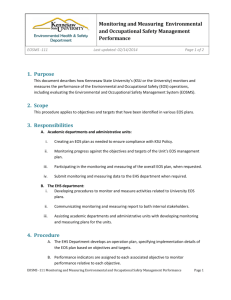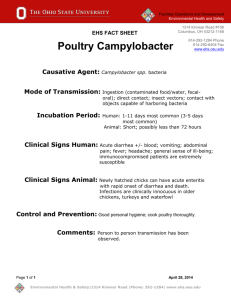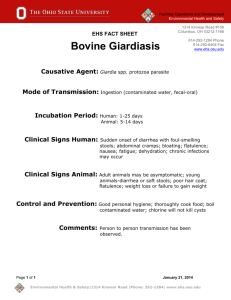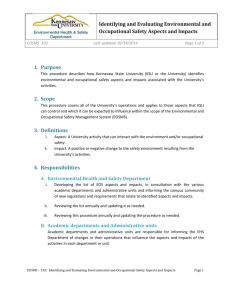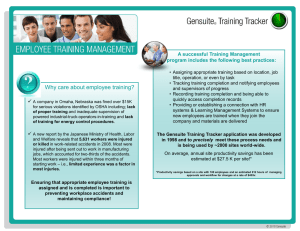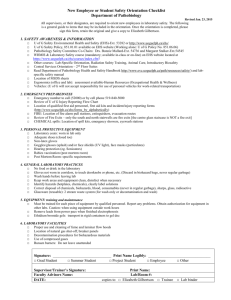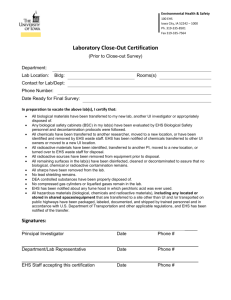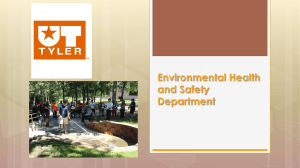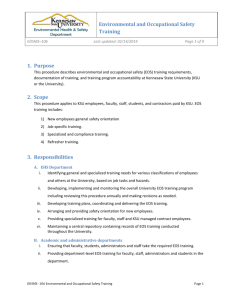Managing Environmental and Occupational Safety Risks and Impacts
advertisement
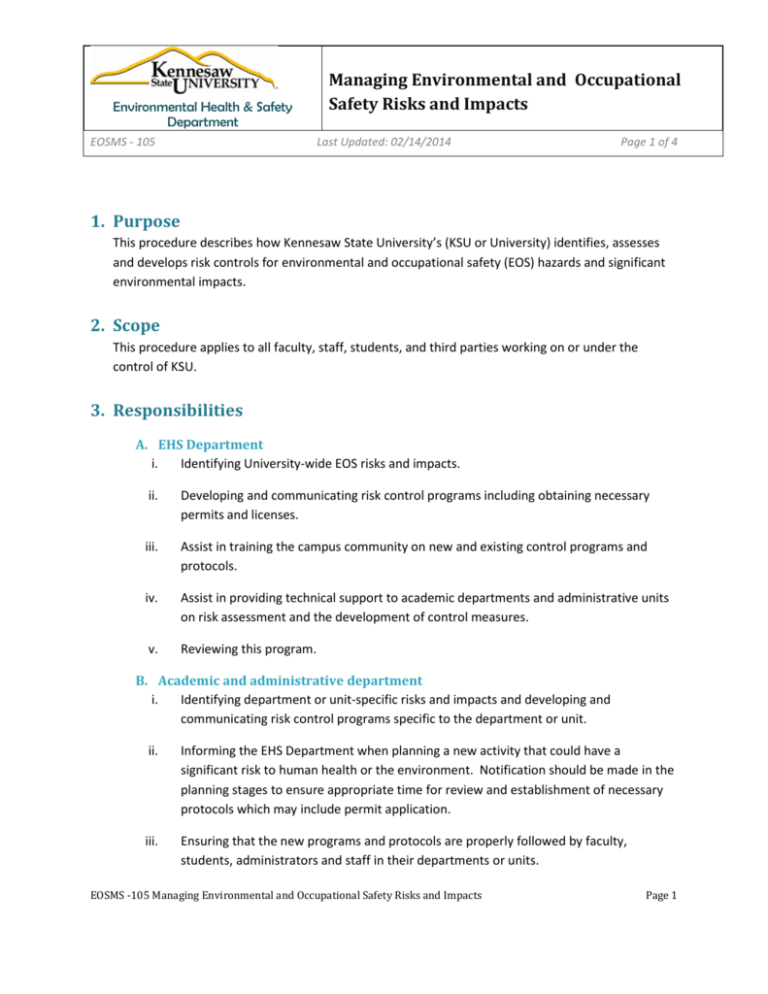
Environmental Health & Safety Department EOSMS - 105 Managing Environmental and Occupational Safety Risks and Impacts Last Updated: 02/14/2014 Page 1 of 4 1. Purpose This procedure describes how Kennesaw State University’s (KSU or University) identifies, assesses and develops risk controls for environmental and occupational safety (EOS) hazards and significant environmental impacts. 2. Scope This procedure applies to all faculty, staff, students, and third parties working on or under the control of KSU. 3. Responsibilities A. EHS Department i. Identifying University-wide EOS risks and impacts. ii. Developing and communicating risk control programs including obtaining necessary permits and licenses. iii. Assist in training the campus community on new and existing control programs and protocols. iv. Assist in providing technical support to academic departments and administrative units on risk assessment and the development of control measures. v. Reviewing this program. B. Academic and administrative department i. Identifying department or unit-specific risks and impacts and developing and communicating risk control programs specific to the department or unit. ii. Informing the EHS Department when planning a new activity that could have a significant risk to human health or the environment. Notification should be made in the planning stages to ensure appropriate time for review and establishment of necessary protocols which may include permit application. iii. Ensuring that the new programs and protocols are properly followed by faculty, students, administrators and staff in their departments or units. EOSMS -105 Managing Environmental and Occupational Safety Risks and Impacts Page 1 4. Procedure A. Managing EOS risks and impacts i. So far as is reasonably practicable, the EHS department in consultation with the University units: a. Identifies environmental and occupational safety hazards and environmental impacts, associated with the University’s activities, processes, products and services; b. Assesses the EOS risks involved; and c. Implements suitable control measures to ensure the EOS risks are eliminated or significantly reduced. B. Risk Assessments Approach and Tools 1) The EOS risk assessments are carried out as follows: i. Before new or altered systems of work are established. ii. Before new plant and equipment are acquired. iii. Before new chemicals and substances are acquired. iv. Before buildings are acquired or leased. v. Before businesses or operational entities are established or acquired. vi. When hazards are identified in the workplace, including when incidents have occurred. vii. When the work environment is altered (for instance: refurbishment or a new building). viii. When new information about workplace risks becomes available. ix. In response to concerns raised by a University employee, safety committee or others at the workplace. x. When required by regulations. 2) The EHS Department develops and publishes suitable risk assessment tools and templates for various processes, activities and materials including the following: i. Chemicals and substances. ii. Plant and equipment. EOSMS - 105 Managing Environmental and Occupational Safety Risks and Impacts Page 2 iii. Buildings, structures and work environments. iv. Processes. 3) Personnel performing risk assessment and control processes use the appropriate risk assessment tools and methodologies and are qualified in the use of the methodology. 4) Hazard or risk assessments are to be carried out by supervisors, Principal Investigators (PI), laboratory personnel, safety committees, EHS staff, consultants or other suitably competent persons. 5) The EHS Department provides training to KSU personnel involved in hazard or risk assessment to ensure they are qualified in use of methodologies and tools. C. Workplace hazard identification and assessment i. Supervisors, PIs and managers proactively identify hazards in their workplaces, including through the use of the following: a. Workplace inspections and/or audits. b. Hazard or incident reports. c. Formal risk assessments. ii. Whenever possible, supervisors, PIs, and managers consult with the employees, safety committees and/or EHS on hazard identification, risk assessment and control processes. iii. University employees, students and contractors are required to report any workplace hazards they are aware of. iv. When a hazard is identified, the supervisors, PIs, and managers assess the risk and implement control measures necessary to address the hazard. Whenever necessary, this is completed in consultation with the EHS Department and/or the unit’s safety committee. v. The supervisors, PIs, and managers ensure that the implemented controls are monitored and reviewed for their effectiveness. vi. The supervisors, PIs, and managers ensure that records of the identification, assessment and hazard control are maintained. D. Management and Operational Risk Control Programs i. The EHS Department develops management programs and operational risk control procedures (Standard Operating Procedures (SOPs)) for addressing significant risks and impacts identified from assessment. EOSMS - 105 Managing Environmental and Occupational Safety Risks and Impacts Page 3 ii. The EHS Department develops appropriate protocols and operational controls to minimize the risk from changes to existing or from new activities. Depending on the particular issue or activity, the EHS Department may establish SOPs and apply for necessary permits or approvals from regulatory agencies. iii. Supervisors, PIs and managers develop SOPs and operational controls for particular activities in their department/lab/unit. The department/lab/unit may use the EOS procedure template developed by EHS. iv. The list of the management programs and operational risk control procedures are published on the EHS website. (www.kennesaw.edu/ehs) v. EHS Department communicates information concerning programs, procedures, and protocols to the faculty, students, administrators and staff involved in an activity. 5. Assessment and Review i. At least annually, the EHS Department reviews this procedure in accordance with University’s Procedure for Documents and Record Management (EOSMS – 110). EOSMS - 105 Managing Environmental and Occupational Safety Risks and Impacts Page 4
